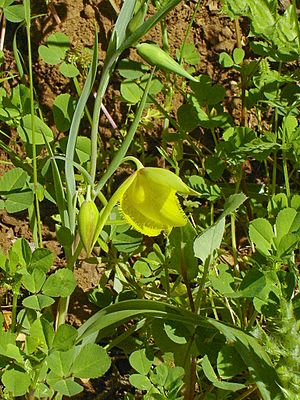Mount Diablo fairy-lantern facts for kids
Quick facts for kids Mount Diablo fairy-lantern |
|
|---|---|
 |
|
| Scientific classification | |
| Genus: |
Calochortus
|
| Species: |
pulchellus
|
| Synonyms | |
Calochortus pulchellus is a special kind of flowering plant. People often call it the Mt. Diablo fairy-lantern or Mount Diablo globelily. It belongs to the lily family. This plant is quite rare and mostly grows in California.
Contents
Where This Plant Grows
The Mt. Diablo fairy-lantern is found almost only in California. It lives mainly around Mount Diablo in Contra Costa County. This area is part of the eastern San Francisco Bay Area.
Historically, this plant was also seen in other parts of northern California. These areas included Marin, Solano, Napa, and Humboldt Counties.
Today, you can find it growing in chaparral and woodland areas. These are mostly on the western slopes of Mount Diablo.
What the Mt. Diablo Fairy-Lantern Looks Like
The Calochortus pulchellus is a perennial herb. This means it's a plant that lives for more than two years and has soft, green stems. Its branching stem can grow up to about 30 centimeters (about 12 inches) tall.
Leaves and Stems
The main leaf at the bottom of the plant can be as long as 40 centimeters (about 16 inches). This leaf stays green even when the plant flowers. There are also two or three smaller leaves higher up on the stem.
Flowers and Petals
The plant produces one flower or a small group of flowers. These flowers usually hang downwards and are often round, like a globe. Their petal tips touch each other.
Each flower has three sepals and three petals. Sepals are like small leaves that protect the flower bud. The sepals and petals are typically 2 to 3 centimeters (about 1 inch) long. They can be light yellow to a deeper yellow color. The inside of the petals feels a bit hairy. They often have yellow hairs along their edges too.
Fruit and Seeds
After the flower blooms, it forms a fruit called a capsule. This capsule is winged and measures about 2 to 3 centimeters (about 1 inch) in length. It holds the plant's seeds.
See also
 In Spanish: Calochortus pulchellus para niños
In Spanish: Calochortus pulchellus para niños

